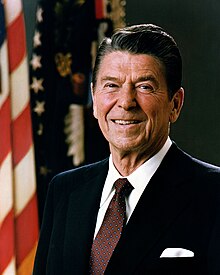
Back رئاسة رونالد ريغان Arabic Kabinett Reagan German Ronald Reaganin hallitus Finnish Présidence de Ronald Reagan French הקבינט של ארצות הברית בממשל רונלד רייגן HE Reaganbyltingin Icelandic Presidenza di Ronald Reagan Italian Kabinet-Reagan Dutch Ronald Reagans regjering NB د رونالډ ریګان ولسمشري Pashto/Pushto
 | |
| Presidency of Ronald Reagan January 20, 1981 – January 20, 1989 | |
| Cabinet | See list |
|---|---|
| Party | Republican |
| Election | |
| Seat | White House |
|
| |
| Library website | |
| ||
|---|---|---|
|
Entertainment and personal 33rd Governor of California 40th President of the United States Tenure Appointments
|
||
Ronald Reagan's tenure as the 40th president of the United States began with his first inauguration on January 20, 1981, and ended on January 20, 1989. Reagan, a Republican from California, took office following his landslide victory over Democrat incumbent president Jimmy Carter and independent congressman John B. Anderson in the 1980 presidential election. Four years later in the 1984 presidential election, he defeated former Democratic vice president Walter Mondale to win re-election in a larger landslide. Reagan served two terms and was succeeded by his vice president, George H. W. Bush, who won the 1988 presidential election. Reagan's 1980 landslide election resulted from a dramatic conservative shift to the right in American politics, including a loss of confidence in liberal, New Deal, and Great Society programs and priorities that had dominated the national agenda since the 1930s.
Domestically, the Reagan administration enacted a major tax cut, sought to cut non-military spending, and eliminated federal regulations. The administration's economic policies, known as "Reaganomics", were inspired by supply-side economics. The combination of tax cuts and an increase in defense spending led to budget deficits, and the federal debt increased significantly during Reagan's tenure. Reagan signed the Tax Reform Act of 1986, simplifying the tax code by reducing rates and removing several tax breaks, and the Immigration Reform and Control Act of 1986, which enacted sweeping changes to U.S. immigration law and granted amnesty to three million illegal immigrants. Reagan also appointed more federal judges than any other president, including four Supreme Court Justices.
Reagan's foreign policy stance was resolutely anti-communist. Its plan of action, known as the Reagan Doctrine, sought to roll back the global influence of the Soviet Union in an attempt to end the Cold War. Under his doctrine, the Reagan administration initiated a massive buildup of the United States military; promoted new technologies such as missile defense systems; and in 1983 undertook an invasion of Grenada, the first major overseas action by U.S. troops since the end of the Vietnam War. The administration also created controversy by granting aid to paramilitary forces seeking to overthrow leftist governments, particularly in war-torn Central America and Afghanistan. Specifically, the Reagan administration engaged in covert arms sales to Iran to fund Contra rebels in Nicaragua that were fighting to overthrow their nation's socialist government. The resulting Iran–Contra affair led to the conviction or resignation of several administration officials. During Reagan's second term, he worked with Soviet leader Mikhail Gorbachev to sign a major arms control agreement. In 1986, Congress overrode Reagan's veto of a bill intended to implement economic sanctions against South Africa's apartheid regime.
Historians and political scientists generally rank Reagan in the upper tier of American presidents, and consider him to be one of the most important presidents since Franklin D. Roosevelt. Supporters of Reagan's presidency have pointed to his contributions to the economic recovery of the 1980s, the peaceful end of the Cold War, and a broader restoration of American confidence. Reagan's presidency has also received criticism for rising budget deficits and wealth inequality during and after his presidency. Due to Reagan's popularity with the public and advocacy of American conservatism, some historians have described the period during and after his presidency as the Reagan Era.


